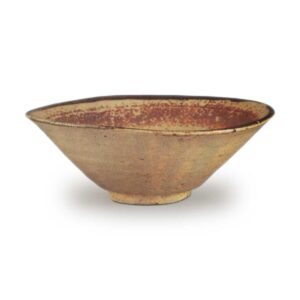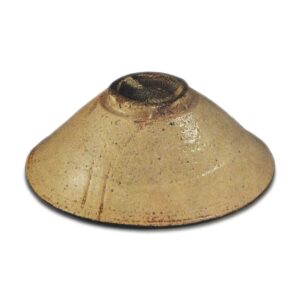

Height: 5.8cm
Diameter: 15.8cm
Height of foot ring: 5.2cm
Height of foot ring: 0.7cm
The name Seto Karatsu comes from the fact that it is Karatsu ware with a Seto-style glaze, and it is a name given by tea ceremony masters in the same way as Choson Karatsu and Higo Satsuma. There are two types: hon-te and kawa-geite, and kawa-geite is particularly famous.
The name “Kiwami” comes from the fact that the white glaze with red rim looks like a whale’s skin, but its elegant and refreshing feel makes it a popular summer tea bowl, especially in the Kyoto-Osaka area, where it is used in summer festivals and has become a popular item, enhancing its name.
The shape is a flat bowl, and the rough crackled white glaze on the rim is decorated with the iron glaze rim-red as mentioned above, and there are three eyes called “cat feet” in the interior, and the tea pool is concave and mirror-like. The glaze is particularly pleasing in its egg-yolk color.
The foot ring is unglazed, and the foot ring is also slightly different from the usual Karatsu style, with a white, rough surface. The shape and size are also fairly consistent, and the rim is decorated in a common way, so it can be seen as a type of formal tea bowl that appeals to tea masters. This tea bowl is from the Oda family of the Chukyo region, and it is famous in the tea ceremony world as the first of the Kiwadate style, and it is a magnificent piece that stands out from the rest, with its characteristic egg-like skin and dignified, vivid rim-red. The way it is held in the hand is also perfect, and the dark red rim is full of charm, with a rich contrast between the thin and thick parts. The tea stains around the rim add to the beauty of the egg-white skin.
The two scratches on the exterior also show a change in the glaze, and this in turn becomes a feature, and the finely trimmed foot ring suggests that it is a work of taste. The foot ring shows creases and some parts are glazed, adding to the charm.
Accessories:
Inner box, paulownia wood
with the same lid, with the inscription “Seto Karatsu”
on the lid. It was known to the world as a famous bowl that was treasured by the tea master Oda Tokubei of the Chukyo region, and in 1932, it was sold at auction for 17,000 yen, raising its reputation at the time.



